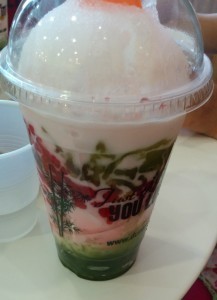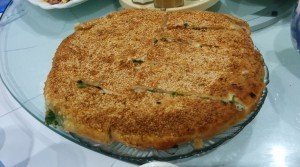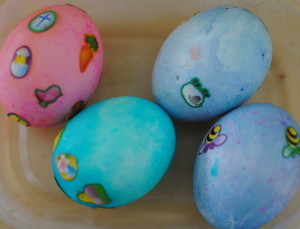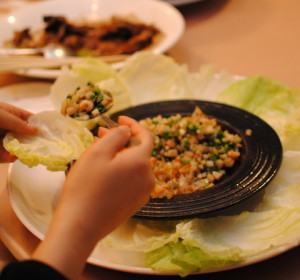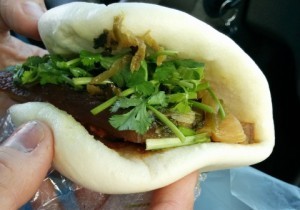Jennifer J. Chow's Blog, page 63
May 12, 2014
Chinese Moms and Lullabies
“If you do not brave the tiger’s lair, how can you capture the cub?” – Chinese proverb
 Even though it’s past Mother’s Day, I hope I still continue to honor and appreciate my mom. My mom is definitely not a tiger mom, although she did expect the best from her children. While growing up, I had a hard time reconciling my mom with the Western archetype I saw on TV (i.e. June Cleaver). As I’ve grown older, I now know better and admire her unique and Chinese shows of affection. Besides the continual blessing of good food, one of my favorite childhood recollections is of sitting in the rocking chair while she sang a simple song. (I’ve even continued the tradition myself.) The lyrics go something like this:
Even though it’s past Mother’s Day, I hope I still continue to honor and appreciate my mom. My mom is definitely not a tiger mom, although she did expect the best from her children. While growing up, I had a hard time reconciling my mom with the Western archetype I saw on TV (i.e. June Cleaver). As I’ve grown older, I now know better and admire her unique and Chinese shows of affection. Besides the continual blessing of good food, one of my favorite childhood recollections is of sitting in the rocking chair while she sang a simple song. (I’ve even continued the tradition myself.) The lyrics go something like this:
“Rock, rock, rock ’til grandma calls.
Grandma says I’m ____.”
(The blank is filled in whatever word you want to stick in. When I was behaving well, it was guai or obedient.)
Another song influenced my childhood; I remember singing it on the sandbox edge while the other more social kids played on the jungle gym or gathered into their cliques. I don’t remember the title, but it had a verse that roughly translated to “I want to fly like the seagull.” Whenever I sang that or other Cantonese songs, I took a piece of my home (and my mother’s love) with me wherever I went.
Thank you for everything, Mom!
May 9, 2014
Foodie Friday: Bee Hoon/Mee Hoon/Mai Fun
Bee Hoon/Mee Hoon/Mai Fun: rice vermicelli
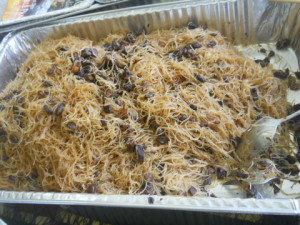 Whatever you call it, it’s thin noodles made from rice. This is not to be confused with bean thread noodles (glassy transparent noodles made from a starch, like mung bean). You can cook the vermicelli in different ways, but I personally like them stir-fried. The key to nice noodles is: 1) soaking them until soft, 2) not using boiling water to do so, and 3) cooking the noodles separate from meat and vegetables (unless you have a stellar non-stick pan).
Whatever you call it, it’s thin noodles made from rice. This is not to be confused with bean thread noodles (glassy transparent noodles made from a starch, like mung bean). You can cook the vermicelli in different ways, but I personally like them stir-fried. The key to nice noodles is: 1) soaking them until soft, 2) not using boiling water to do so, and 3) cooking the noodles separate from meat and vegetables (unless you have a stellar non-stick pan).
Here are my top three versions of rice vermicelli:
Taiwanese bee hoon: dry-style, flavored with sliced pork or dried shrimps
Hokkien mee hoon: noodle soup (in Penang) or fried dish (in Singapore) featuring prawns with a touch of lime (note: the similarly named Kuala Lumpur dish boasts thick noodles in a dark sauce)
Singaporean mai fun: throw in your meats & vegetables, and don’t forget the curry powder! (I read somewhere that the curry flavoring may be an American addition, but I like it anyway.)
Do you know a food with several names to it?
May 5, 2014
My Bamboo Generation
“Sow melon, reap melon; sow beans, reap beans.” -Chinese proverb
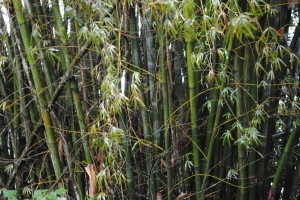 Bamboo is hardy. It’s one of the first plants I ever received and requires little care. Whether placed in soil or a vase of decorative stones, it revives with a douse of water. According to feng shui rules, it attracts good luck and fortune. In fact, I featured bamboo centerpieces at my wedding.
Bamboo is hardy. It’s one of the first plants I ever received and requires little care. Whether placed in soil or a vase of decorative stones, it revives with a douse of water. According to feng shui rules, it attracts good luck and fortune. In fact, I featured bamboo centerpieces at my wedding.
However, in Cantonese, there’s a term known as “jook-sing.” It refers to a hollow bamboo pole used as a measuring tool. But really it’s slang for Westernized (think: American-born) Chinese because we’re caught in the middle, like water in a segmented bamboo, unable to flow out and connect to either end. I’ve been called this and other terms: twinkie, banana. Note that both the previous food items are yellow on the outside but white on the inside. I think you get the picture.
I’m still struggling to balance my identity even after decades of juggling. It helps that May is Asian American and Pacific Islander (AAPI) Heritage month, and I know I’m not alone.
Bamboo grows fast, at recorded rates of 98 inches in 24 hours. Another inspiring thing about bamboo is that it’s one of the strongest materials around, even better than steel. I hope to grow in my knowledge of the upbringing and background that makes me unique, and stay strong in celebrating my Asian Americanness.
Happy Heritage Month!
May 2, 2014
Foodie Friday: Chè
My first… Chè.
I’ve decided to not just write about dishes from cultures I’m associated with–American, Chinese, Malaysian, and Taiwanese–but also to reveal new foods that I’m discovering. Here’s my first foray into the unknown.
Chè: a Vietnamese dessert; exotic fillings in a milky bath, often served cold
This is a refreshing drink, perfect for the heat wave we’ve been experiencing (I blame you, Santa Ana winds). It’s also known as “three color drink” because of the different fruits and jellies found in the beverage. Cups of chè can be found in refrigerators at Vietnamese grocery stores.
I ordered mine at a cafe (chè trái cây, to be exact). I was expecting more of a sweetness to this drink, but it wasn’t super-sugary. I was thinking something along the lines of sweetened soy milk, while it turned out more like plain soy milk. Nevertheless, it does cool you down. Also, I like how it’s similar to shaved ice (and I don’t mean snow cone), with its array of added ingredients.
Here’s the rundown of things floating in the coconut milk bath:
1. Lychee- Juicy fruit with bumpy red skin (not edible); has translucent color
2. Longan- Similar to lychee, but with a smooth brown skin; clear in hue and with a piercing sweet taste
3. Red tapioca- A starch, like that found in boba, but smaller and with bright red coloring
4. Jackfruit- Oval fruit, similar to durian; flesh inside is yellow and banana-shaped
5. Palm seed- The inner extractions of palm fruit
6. Jello- Gelatin strips
Want to make your own? See instructions .
Tried any new foods lately?
April 28, 2014
A Little Bit of Luck
“Water can both sustain and sink a ship.” -Chinese proverb

Salt over the shoulder. Rabbit’s foot. Water.
The other day, people spilled water on me twice. It’s good luck, my brother reassured me. I hope so. Otherwise, it’s just more laundering for me.
In Chinese, water signifies wealth. I haven’t heard anything similar in America. I wondered what parallels I could discover between good luck charms across Eastern and Western cultures. Here’s a chart of a few of my findings:
.tftable {font-size:12px;color:#333333;width:100%;border-width: 1px;border-color: #729ea5;border-collapse: collapse;}
.tftable th {font-size:12px;background-color:#acc8cc;border-width: 1px;padding: 8px;border-style: solid;border-color: #729ea5;text-align:left;}
.tftable tr {background-color:#d4e3e5;}
.tftable td {font-size:12px;border-width: 1px;padding: 8px;border-style: solid;border-color: #729ea5;}
.tftable tr:hover {background-color:#ffffff;}
Eastern
Western
Significance
Four-leaf clover
Bamboo plant
Each clover leaf represents something: 1) faith, 2) hope, 3) love, and 4) luck.
Bamboo is the ideal mix of the thriving water and wood element.
Ladybug
Cricket
Ladybugs help farmers by eating pests, like aphids. They’re also linked with the Virgin Mary (known as “Our Lady” to devout Catholics).
Crickets lay hundreds of eggs, a symbol of vitality. Their singing is revered and serves as a reminder of happiness.
Rabbit (foot)
Tortoise
The left hind leg of the rabbit brings luck. The animals are prized for their fertility, and their “magical” running ability of landing on their hind legs first.
Tortoises are symbols of longevity, since they can survive for more than 100 years. They also are linked to health, with their shells being used for numerous remedies.
April 25, 2014
Foodie Friday: Sesame Bread
Sesame bread: thick bread with an interior laced with scallions, and sesame seeds sprinkled on top
A common breakfast food or snack in Northern China, this bread requires no baking. That’s right–just fry it up in a pan! (The Chinese Islamic cuisine features an unleavened version, which results in a flatter bread.)
There’s an interesting contrast with the soft inside against the crisp outside. Sometimes the green onions can taste overpowering, but it’s a great way to sneak in vegetables and boost your vitamin K level. I also like the nutty flavor of the seeds, enhancing the taste of the plain outer layer. Sesame bread is served in pretty thick wedges, so it’s not a dish for the carb-wary. Here’s a video on how to make it:
April 21, 2014
Red Egg and Ginger Parties
“Do not kill the hen for her eggs.” -Chinese proverb
Eggs abounded everywhere this past weekend (plastic and real). We even decorated some ourselves:
In Chinese, there’s also a custom involving dyed eggs. Red eggs. (As an aside, Orthodox Christians also use red eggs, symbolizing the blood of Christ and rebirth.) My own reference is to a cultural red egg and ginger party.
These festive occasions arrive on the one-month birthday of a new baby in the family. In the old days, the one-month mark was very significant. Because of the high mortality rate, babies who succeeded in reaching that age would usually go on to survive.
What’s the importance of the different components?
Egg–to symbolize life and fertility
Red–for good luck and prosperity
Ginger–to add hot spice and balance yin & yang; also to provide energy to the new mother
April 18, 2014
Foodie Friday: Lettuce Wrap
Lettuce wrap: An array of meat and vegetables wrapped up in lettuce
There’s mention of a lettuce sandwich in The Century Illustrated Monthly Magazine from 1894. It was also seen all across the United Kingdom and United States in the early mid 20th century. I’m not sure when it evolved into finding a place in Asian restaurants, but now the dish is quite common. (I even saw them offered at Souplantation recently.)
Lettuce wraps are a great way to get greens into your body, and the filling can be made up of anything you desire. Plus, they’re healthy and naturally gluten-free. For the lettuce, you would want to use:
Romaine for its crispiness; works well with strong flavors (think: Caesar salad)
Butterhead for a soft and tender wrapping; very flexible type of leaf
Red leaf or green leaf, if you want a texture more in the middle; also great for adding a dash of color
Ready to cook? Go ahead and try one of these fifteen variations of the lettuce wrap.
April 14, 2014
Battling Eczema
“You do not need a butcher’s knife to kill a chicken.” -Chinese proverb
But sometimes I feel like carrying a machete to fight eczema. Personally, I don’t suffer from this, but through a certain combination of genes and environment, the skin condition passed down to my child.
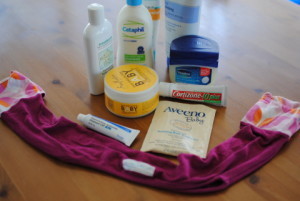
ScratchMeNot, surrounded by eczema lotions
Findings from population-studies done in America and England show a high prevalence of black and Asian children with eczema. Interestingly enough, East Asian parents who are recent immigrants may not actually be allergy sufferers themselves. It seems, then, that environment really does play a big role in eczema.
What is eczema? It’s an inflammatory condition of the skin. Symptoms include rashes, itchiness, scaling, and oozing. Babies can start showing signs of eczema from a few weeks of age, although it typically begins a few months after birth. Often, infants can outgrow this condition by the time they turn 2 or 3.
I hoped that would happen in my case, but it didn’t. Finally, though, it’s come under control. I’ve had an arsenal of supplies for my war against eczema. These were:
Natural
Jojoba oil- Liquid from the seed of a plant indigenous to southern United States and northern Mexico. Supposed to moisturize without clogging pores and promote balanced oil production in the skin. (Jojoba oil went on smoothly enough, and I have a girlfriend who swears by it. Unfortunately, it was too messy to control and seemed to increase itching for my little one.)
Shea butter- Loaded with lots of good vitamins. Thick and creamy, it’s a beautiful moisturizer. (Shea butter was a little too thick and smeared everywhere. It’s also not a good product for those with nut allergies.)
Extra virgin olive oil- An all-natural oil that is safe to use because most people are not allergic to it. Extra virgin is the purest form that can purchased. It’s been used both internally and externally for ages. (Nice moisturizer that is natural and also affordable.)
Oatmeal baths- Whether using prepackaged Aveeno ones or your own cylinder of rolled oats, oatmeal soothes the skin. It can be made at home by blending the oats into a very fine powder before adding it to bath water. (Interesting idea, but the kids didn’t enjoy the milky water. Plus, it left my bathtub full of oat bits and pieces, which probably ended up clogging our drain.)
Socks/ScratchMeNot- The cuffs of old baby socks can be cut and made into “bracelets.” These new accessories can hide dry skin from curious fingers. There’s also a fancier ScratchMeNot fabric that stretches across the back like a shrug or cardigan. The sleeves can be folded over to create mitten-like cocoons for the hands. (These work really well in the younger years. Later on, though, they want to free their hands and use them.)
Mild:
Eucerin/Aquaphor/Cetaphil- The first two are top-selling lotions for eczema. They both moisturize and are formulated for sensitive skin. And Cetaphil has a new line out with the National Eczema Association logo on it. (Between the top two, Eucerin worked better for me because it had a creamier consistency. Aquaphor didn’t seem to cover the area thoroughly enough. I like Cetaphil the most, though, because it covers just enough while rubbing into the skin easily.)
Vaseline- I have friends who love petroleum jelly for their eczema. It can seal out potential irritants. (My pediatrician doesn’t recommend it because it works as a barrier, not allowing skin to breathe and not actually moisturizing.)
“Natural” lotions- I’ve tried organic ones and everything-free products. Also, aloe vera concoctions. (It’s great to be wary of chemicals, but none of these products really seemed to work well.)
Hydrocortisone (drugstore)- Not meant to use for prolonged periods, this is a quick fix tool. It has anti-inflammatory properties that usually take away the rash in 2-3 days. (This helps with tiny itches, but for more advanced rashes, I needed something stronger.)
Harsh:
Chlorine bath- That’s right, you mix together a certain ratio of chlorine to bath water. It helps fight off the bacteria that can accompany eczema. (This helped squash any bacterial infections for us and also cleaned the tub! Of course, it would be my last line of defense because it is still bleach.)
Desonide .05%- A stronger member of the corticosteroid (think: hydrocortisone) family. It comes in both oitment and cream formulations. (The dermatologist recommended the ointment version because it stayed on better. True.)
Triamcinolone Acetonide Ointment .1%- An even stronger option. It comes out clear and is odorless. (Very effective, and it stopped a blooming rash in its tracks.)
Final Verdict: 1) Triamcinolone acetonide ointment for the big jobs; 2) Olive oil with an eczema cream (I like Cetaphil Restoraderm lotion) for moisturizing; 3) Here’s a bonus: Cetaphil RestoradermWash instead of usual body wash to protectively coat the skin during baths and showers
April 11, 2014
Foodie Friday: Pork Belly Sandwich
Pork belly sandwich: tender meat sandwiched in a steamed bun wrapper
Pork belly is a totally accurate name; it comes from the underside of the pig. You might be surprised to learn that bacon is found in there, too. Likewise, both cuts of meat are pretty tasty. (In fact, pork belly is a very common ingredient in both Chinese and Korean cuisines.)
Now imagine that succulent meat wrapped in a steamed bun, similar to the fluffy pancakes found in (at least, Americanized versions of) Peking Duck. Throw in a few vegetables and a healthy dose of cilantro. That’s what the belly pork sandwich is: a scrumptious all-in-one-meal that combines hearty meat with flavor with the tang of herbs.

